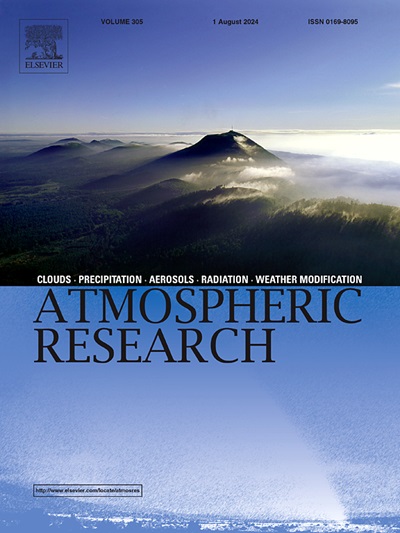东南太平洋典型地区单层层状云的分布特征及其成因
IF 4.5
2区 地球科学
Q1 METEOROLOGY & ATMOSPHERIC SCIENCES
引用次数: 0
摘要
单层层状云(Sc)作为层状云中最常见的云系,由于其持续时间长、覆盖范围广,在全球辐射平衡中起着重要作用。然而,它们的形成和辐射强迫仍有很大的不确定性。本文使用2007 - 2010年Cloudsat 2B-CLDCLASS-LIDAR产品与其他云类型进行区分。利用同期的ERA5数据和2B-FLXHR-LIDAR对其形成机制和辐射效应进行了研究。结果表明:单层Sc在空间分布上表现出明显的季节变化,与全层湿度(twv)和对流层低层稳定性(LTS)分布密切相关。不同的气溶胶浓度会改变它们的效果。当气溶胶光学深度(AOD)小于0.12时,twv的增加抑制了云的形成,而较强的LTS则放大了这种抑制作用。然而,作为AOD >;0.14, twv促进云分数(CF),而LTS减弱这一作用。CGT是一项重要的气象指标,固定后可减少气象因子(如twv、LTS)对云结构的影响,从而更清晰地评估CF对云辐射效应(CRE)的影响。结果表明,CF对短波辐射强迫(CRE_SW)的影响大于对长波辐射强迫(CRE_SW)的影响,但其影响取决于云的几何厚度(CGT)。当云层较薄时(CGT <;310.3 m), CF增强了云短波和长波辐射效应,造成区域降温效应(slope_CERnet =−25.2);厚云层(CGT >;310.3 m)会抑制CRE_SW,但会增强CRE_LW,从而降低冷却效果(slope_CERnet = - 19.89)。这项研究将有助于改进云辐射强迫的模拟,从而减少气候变化评估中的不确定性。本文章由计算机程序翻译,如有差异,请以英文原文为准。
Distributional characteristics and causes of single-layer stratiform clouds over typical region in the southeastern Pacific Ocean
Single-layer Stratiform clouds (Sc), as the most common cloud system for stratiform clouds, plays an important role in global radiative balance due to their duration and extensive coverage. However, there are still substantial uncertainties in their formation and radiative forcing. In this paper, we use the Cloudsat 2B-CLDCLASS-LIDAR product from 2007 to 2010 to distinguish it from other cloud types. ERA5 data and 2B-FLXHR-LIDAR from the same period are used to investigate its formation mechanisms and radiative effects. The results show that the single-layer Sc exhibits obvious seasonal variation in the spatial distribution, which is closely related to the distribution of whole-layer humidity (TCWV) and Lower Tropospheric Stability (LTS). Different aerosol concentrations alter their effects. When aerosol optical depth (AOD) is less than 0.12, increased TCWV suppresses cloud formation, amplified by stronger LTS. However, as AOD > 0.14, TCWV promotes cloud fraction (CF), while LTS weakens this effect. CGT is a key meteorological indicator that, when fixed, reduces the impact of meteorological factors (e.g., TCWV, LTS) on cloud structure, enabling a clearer assessment of CF' s effect on cloud radiative effect (CRE). The results show CF has a larger impact on shortwave radiative forcing (CRE_SW) than on longwave (CRE_SW), but its effect depends on the cloud geometric thickness (CGT). When the cloud layer is thin (CGT < 310.3 m), the CF enhances the cloud shortwave and longwave radiative effect, resulting in a regional cooling effect (slope_CERnet = −25.2); the thick cloud layer (CGT > 310.3 m) will inhibit CRE_SW but enhance CRE_LW, thereby diminishing the cooling effect (slope_CERnet = −19.89). This study will help improve the simulation of cloud radiative forcing, thereby reducing uncertainties in climate change assessments.
求助全文
通过发布文献求助,成功后即可免费获取论文全文。
去求助
来源期刊

Atmospheric Research
地学-气象与大气科学
CiteScore
9.40
自引率
10.90%
发文量
460
审稿时长
47 days
期刊介绍:
The journal publishes scientific papers (research papers, review articles, letters and notes) dealing with the part of the atmosphere where meteorological events occur. Attention is given to all processes extending from the earth surface to the tropopause, but special emphasis continues to be devoted to the physics of clouds, mesoscale meteorology and air pollution, i.e. atmospheric aerosols; microphysical processes; cloud dynamics and thermodynamics; numerical simulation, climatology, climate change and weather modification.
 求助内容:
求助内容: 应助结果提醒方式:
应助结果提醒方式:


